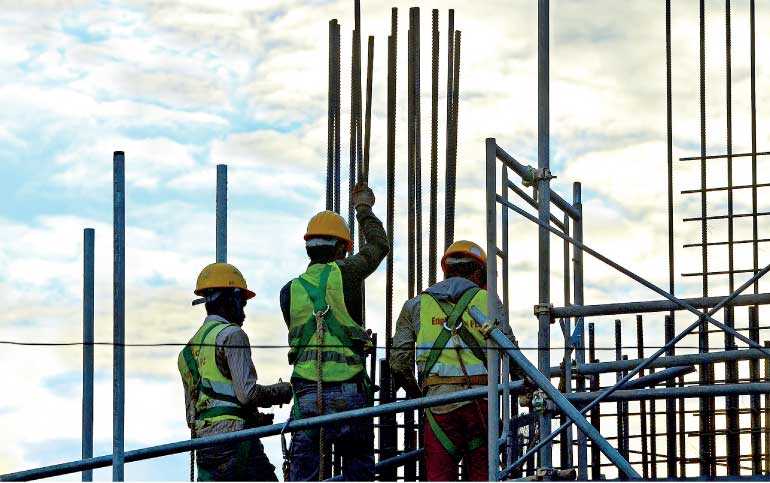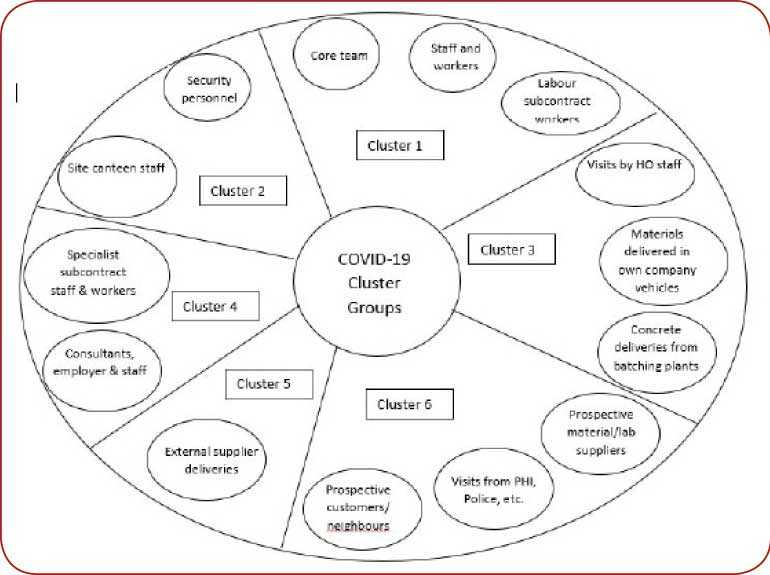Sunday Dec 07, 2025
Sunday Dec 07, 2025
Monday, 11 May 2020 00:32 - - {{hitsCtrl.values.hits}}

Workers at a construction site - Pic by Shehan Gunasekara
The Government, under Press Release 93, dated 4 May, has explained how it plans to bring back normalcy to public life while curfew will still be in place in the Colombo, Gampaha, Kalutara and Puttalam districts.
It explains that public and private sector institutions should recommence work starting from 11th May 2020. Heads of government institutions and private sector companies can decide the number of staff and workers who will be requested to report to work starting from the above date, with the requirement to follow the workplace guidelines published in this regard by the Health Ministry.
Project managers and activity centre managers of construction companies who plan to recommence work on 11 May need to fully understand the risks involved while operating a site under the prevailing conditions in which the COVID-19 pandemic has not been fully brought under control. As per Government information, the pandemic is in stage 2 and the spread has been controlled satisfactorily upon having identified the infected clusters.
Due to economic and political pressures, the Government seems to be under pressure to bring back normalcy to public life as early as possible, but if this decision backfires, the country will end up going into stage 3 of the pandemic.
It will be the prime responsibility of all citizens to understand the risks involved if the pandemic reaches stage 3 or 4, like what happened in countries like China, Italy, and Spain. Hence it will be of great importance to carefully follow the guidelines published by the President’s Office and Ministry of Health in controlling the spread any further.
The situation is such that it will be the responsibility of every manager to ensure that his work location is free of COVID-19. All managers should also realise the fact that in case a person within his work location is found to be infected while the site is in operation after recommencement of work, the project site will be closed by the Government and will be identified as a new COVID-19 cluster. No manager would like to face that situation.
This article tries to explain the importance of identifying various risk groups involved when work recommences at work sites and activity centres, so that the managers can differentiate their approach in dealing with various risk groups in their efforts to avoid their staff and workers getting infected during the initial time period following recommencement of work. The initial two-four weeks will be the most critical time period if the country is to avoid going into stage 3 and 4.
Identifying risk clusters and defining rules for each risk cluster will be solely under the control and discretion of the Manager. What is explained in this article is only one such example and how the writer has approached managing different clusters.
Stages of the COVID-19 pandemic
The following are the stages of the COVID-19 pandemic, as mentioned in the Economic Times, India, on 30 March.
We can approximately demarcate two risk periods after recommencement of work for government institutions and the private sector on 11 May.
Risk period 1
- Government has given people the opportunity to adjust to work recommencement in a completely new environment that has been created after the pandemic.
- This will be an observation period for the health authorities to determine whether stage 2 of the pandemic has been managed well and if it has not reached stage 3.
- If it is confirmed after recommencement of work that the country has satisfactorily contained the spread within stage 2, then in two-four weeks’ time, Government may relax control measures further for the country to restore normalcy to a higher degree.
- Very limited public transport will be available.
- This period will end if new clusters are not identified after a reasonable time period of the last cluster.
- People and companies should be cautious and observant during this time period. They should only carry out limited activities with the engagement of a minimum number of people.
- Need to understand that this is only an observation period.
Risk period 2
- Companies can restore their operations to previous levels before the pandemic.
- Schools and universities will be reopened.
- All the identified cases have been treated and discharged from the hospitals.
- No further risks regarding spread of virus through local cases.
- Inward airport arrivals will still be quarantined until the global situation is restored to normalcy.

Virus spread cluster analysis
The example taken is a building site where workers stay on the site premises and staff accommodations are within a 1 km radius.
Cluster 1
Cluster 1 is a low- to medium-risk group, comprising the company’s and labour subcontractors’ staff and workers. A higher percentage of staff and workers, after they report to work, will stay in company provided accommodations.
Only very few staff and workers will travel daily from home. The majority will be from distant locations and usually go home only once a month during site shutdown periods.
If they report to work free of the virus, the risk of contracting the virus within the site will be moderate. If they can be isolated from other high-risk clusters and be kept within the site and their accommodations under controlled conditions, this group will pose a low to moderate risk of spreading the virus. About 85% of the site population belongs to this group.
Cluster 2
Cluster 2 is a high-risk group which can be managed and converted to a medium-risk group. This group mainly comprises security personnel and canteen workers who frequently change roster and can be in and out of site frequently. However, the manager can put in place controls and negotiate with them to contain their workers within the site premises through additional negotiations with the security company and canteen service providers.
There may be shift changes for the security staff. If they go out of site when they are not on duty, it could increase the risk of exposure to the virus. Hence special arrangements need to be made to limit the security personnel to a select number of people who will remain within the site and change their duties rotationally. If this group can be contained within the site, their risk levels can be reduced. However, security personnel will be in contact with unknown people who come to the site for various reasons. They will be the first contact with such people, who are in the high-risk category. Hence, special precautions should be set up to mitigate such risks.
The people who work at the worker canteen are those who may be from the same area or visit their homes daily after work is over at the site. Such people may not be very reliable and may not work with high discipline. Specific restrictions need to be imposed to avoid this group of people becoming a very high-risk category. As they cook and serve food to most of the workers, if they become infected, they can infect many people in one single instance.
Cluster 3
This group comprises company staff who visit the site from the head offices and central workshops and the company drivers who deliver finished products and raw materials.
These people are company employees who come to site in company vehicles. They are expected to follow company guidelines strictly in order to control the pandemic. However, they come from other locations and may visit other places during their journey to the site. Hence they fall under the medium-risk category, where certain controls need to be adhered to.
Cluster 4
This cluster comprises consultants, their resident staff, specialist subcontractor staff and their workers.
This is a controllable high-risk cluster, which has higher chances of bringing the virus to the site. They may visit the site but also travel to other locations and can get exposed to infected people in other places.
The consultant’s representative staff, who travel daily to the site from other locations, have to be isolated in their separate site office. When they visit the site jointly with the company’s project staff for inspections, necessary distancing requirements should be followed.
If the specialist subcontractors’ workers do not stay within site accommodations and they travel daily to the site, they will become a high-risk group.
Cluster 5
This cluster comprises people from various material suppliers and service providers who come to the site in their own vehicles to deliver materials and services. Delivery of reinforcement is one such example. This is a very high-risk cluster as their behaviours are beyond the manager’s control. People who come to deliver materials to the site, such as drivers and cleaners, cannot be expected to have the necessary discipline and knowledge to avoid contracting the virus. The documents which they bring to the site with the deliveries could be contaminated. Hence a high level of control needs to be planned for this cluster.
Cluster 6
This group comprises people who visit the site for various inquiries, such as people from regulatory authorities and prospective customers.
People of this cluster pose higher risks of virus spread due to their unknown nature. Once they initially report to the security point, the admin officer should be informed and must deal with them. He will attend to their requirements promptly and briefly without prolonging contact with them. Prospective customers will only be handled by the client’s staff without any possible contact with company staff.
Prospective suppliers will not be entertained unless it is very essential during Period 1.
Final note
The approach given in this document is only a concept and not a guideline. Adopting such a systematic approach to identifying and differentiating various risk groups involved during Period 1 will enable companies to manage the virus and the risk of spreading it better and will be able to cut down unnecessary expenditure if they follow a uniform procedure in dealing with groups belonging to low-, medium- and high-risks.
This will also enable the manager to focus more on smaller high-risk groups with higher intensity and effort of control, and use standard hygienic procedures for the low- to medium-risk groups, which comprise the majority population of a project site or an activity centre.